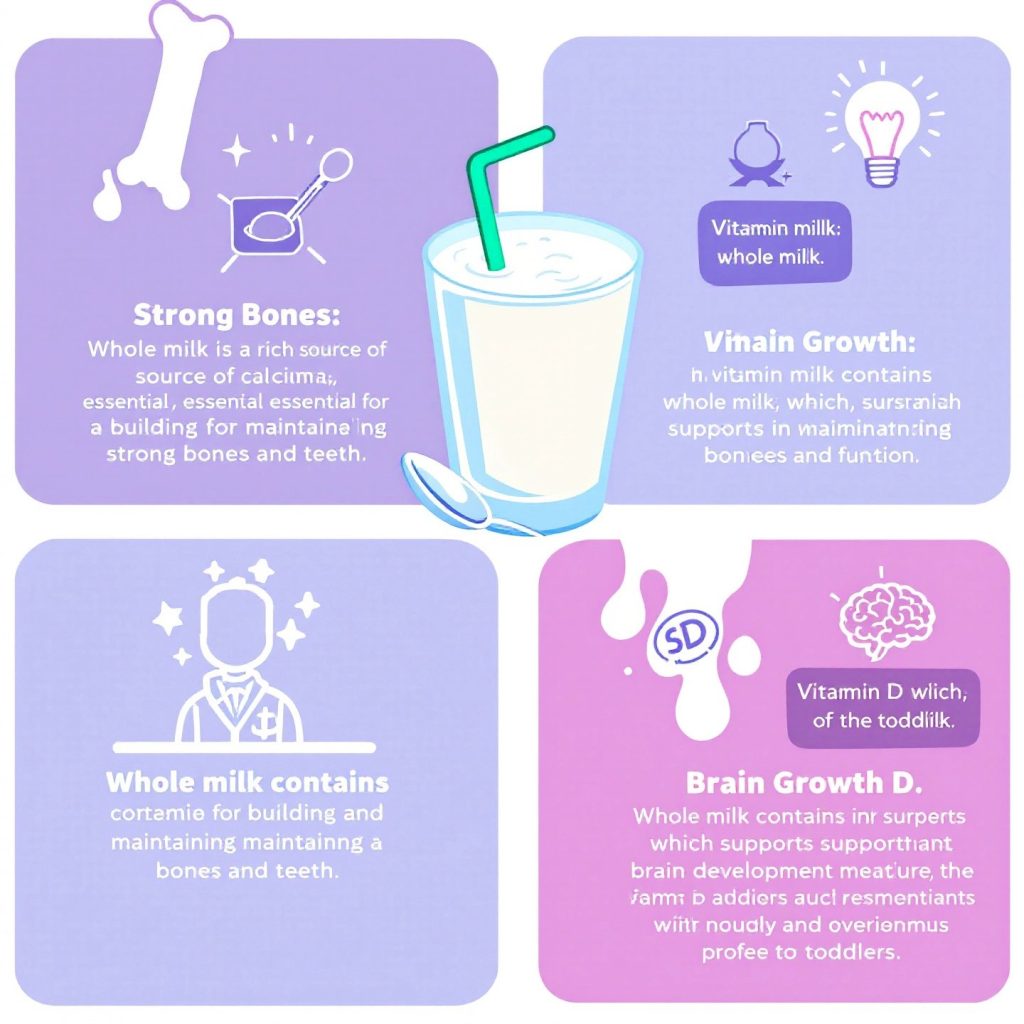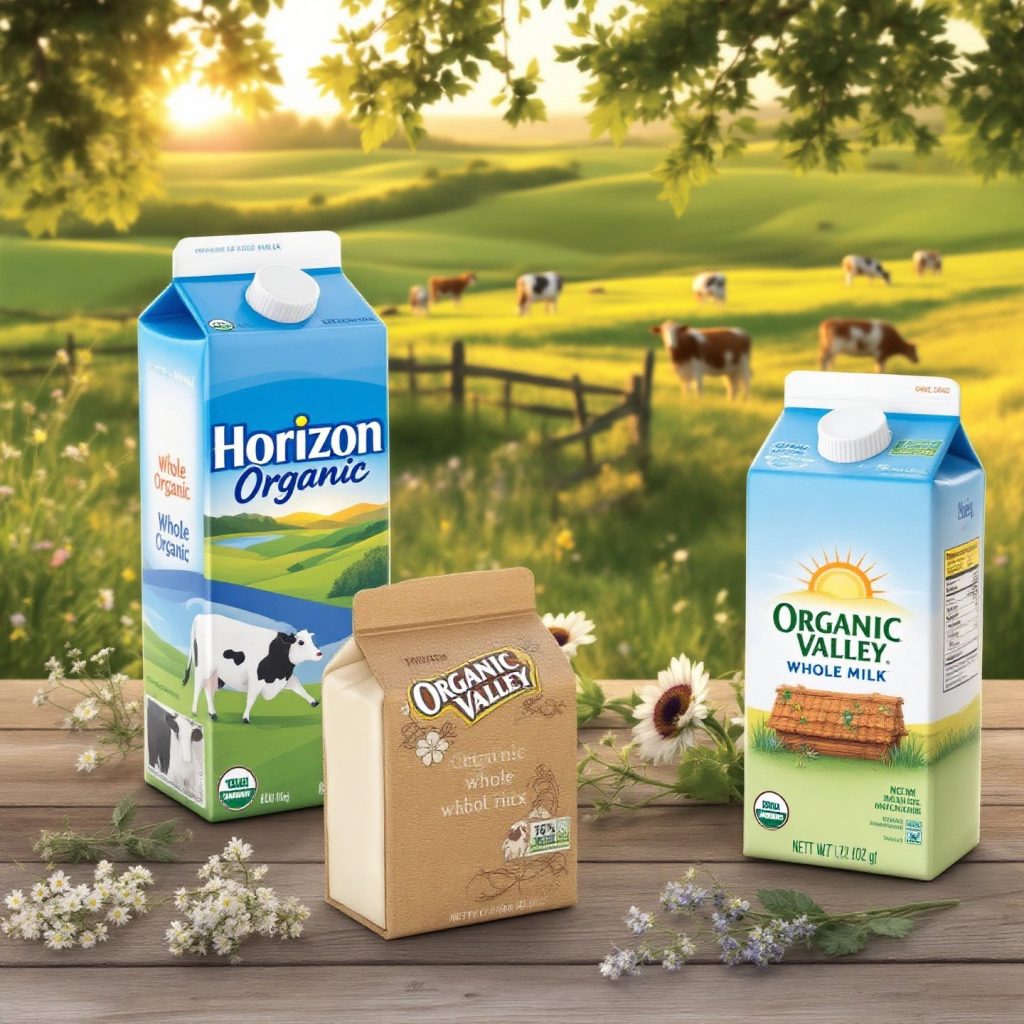Introduction: The Importance of Whole Milk for Toddlers
As your child reaches the significant milestone of their first birthday, their nutritional needs evolve, marking the transition from breast milk or formula to whole cow’s milk. This shift is not merely a dietary change but a crucial step in supporting your toddler’s growth and development. Whole milk plays a vital role in a toddler’s diet, primarily due to its rich content of essential nutrients, such as calcium and vitamin D, which are fundamental for building strong bones and teeth.
Whole milk is particularly important for 1-year-olds as it provides the necessary fat content that is vital for brain development and overall growth. According to the American Academy of Pediatrics, the fat found in whole milk acts as a significant energy source, supporting the rapid brain growth that occurs during the early years of life. This makes the introduction of whole milk a noteworthy event in your child’s nutritional journey, ensuring they receive the balanced nutrients required for healthy development.
Moreover, whole milk is often fortified with vitamin D, a nutrient that aids in the absorption of calcium, further enhancing its bone-strengthening benefits. It’s important to note that whole milk should be introduced only after the child turns one year old, as introducing it earlier can pose health risks, such as intestinal bleeding or kidney strain due to its high protein and mineral content (CDC).
As you prepare to incorporate whole milk into your toddler’s diet, understanding its significance and benefits can help you make informed decisions about the best options available. This guide aims to explore these aspects, providing you with comprehensive insights into choosing the best whole milk for your 1-year-old.

Nutritional benefits of whole milk for toddler growth and development (AI-generated)
Nutritional Benefits of Whole Milk for 1-Year-Olds
Whole milk is a powerhouse of essential nutrients that cater to the unique dietary requirements of toddlers, particularly those who have just celebrated their first birthday. Its nutritional profile is specifically advantageous for brain and bone development, which are critical during this early stage of life. Whole milk provides a substantial amount of calcium and vitamin D, nutrients crucial for building strong bones and teeth. This is especially important as toddlers begin to explore their environment more actively, requiring robust skeletal support.
Essential Fat Content for Energy and Growth
One of the standout features of whole milk is its fat content, which is significantly higher than that of reduced-fat or skim milk. This fat is not just a source of calories; it plays a vital role in supporting brain development and providing energy. The American Academy of Pediatrics underscores the importance of dietary fats in whole milk for toddlers, as these fats contribute to the rapid brain growth occurring during the early years (Nutrition.org).
The fat in whole milk is primarily composed of saturated fatty acids, which have been shown to support the development of the central nervous system. This makes whole milk an integral part of a toddler’s diet, ensuring they have the energy needed for both physical activities and cognitive development.
Comparison with Other Milk Types
While all types of milk offer essential nutrients, whole milk is particularly recommended for toddlers due to its higher fat content. In contrast, skim and low-fat milk have reduced fat levels, which might not provide the same energy and developmental benefits required at this growth stage. According to recent studies, the consumption of whole milk is not associated with unhealthy weight gain in children and may even aid in maintaining a healthy body composition (US Dairy).
In addition to its fat content, whole milk contains proteins such as casein and whey, which are vital for muscle development and repair. These proteins, along with the milk’s natural sugars and other micronutrients, contribute to a balanced diet that supports overall growth and development.
As you consider the best whole milk for your 1-year-old, understanding its comprehensive nutritional benefits will help you make informed choices that align with your child’s developmental needs. The next section will explore some of the top whole milk brands recommended for toddlers, providing insights into their nutritional content, taste, and availability.

Top whole milk brands recommended for toddlers (AI-generated)
Top Whole Milk Brands for 1-Year-Olds
When selecting the best whole milk for your 1-year-old, it’s essential to consider brands that prioritize nutritional value, taste, and availability. Among the myriad of options available, certain brands stand out for their commitment to quality and health benefits, making them popular choices among parents.
Horizon Organic Whole Milk
Horizon Organic is a well-regarded brand known for its commitment to organic farming practices. Their whole milk is sourced from cows that are not treated with antibiotics or growth hormones, ensuring a pure and natural product. This milk is a favorite among parents seeking organic whole milk for babies due to its creamy texture and rich taste, which many toddlers enjoy. Additionally, Horizon Organic offers a lactose-free version, making it suitable for toddlers with lactose intolerance without compromising on the essential nutrients.
Organic Valley Grassmilk
Another top contender is Organic Valley’s Grassmilk, which is produced from cows fed 100% organic grass. This milk is not only organic but also offers the added benefit of omega-3 fatty acids, which are crucial for brain development. The brand’s commitment to sustainable and ethical farming practices makes it a reliable choice for health-conscious parents. The subtle seasonal flavors in their milk, resulting from the cows’ varied diet, can be an added delight for young taste buds.
Maple Hill Organic Whole Milk
Maple Hill is a frontrunner in the realm of organic dairy products, offering milk that is both grass-fed and organic. Known for its transparency in farming practices, Maple Hill provides milk that is rich in healthy fats and nutrients essential for toddler growth. Though it might be priced higher than conventional options, the nutritional benefits and ethical production standards justify the cost for many families.
Considerations When Choosing a Brand
When evaluating the best whole milk brands for toddlers, consider factors such as the milk’s fat content, availability in your area, and whether it meets your child’s dietary needs. Organic options typically ensure the absence of synthetic pesticides and hormones, which is a priority for many parents. Additionally, taste and texture can vary between brands, so it might be worthwhile to try a few to see which one your toddler prefers.
Choosing the right whole milk for your toddler is a decision that balances nutritional needs, ethical considerations, and personal preferences. By selecting a reputable brand, you can ensure that your child receives the best possible start in their dietary journey. The next section will delve into key considerations for choosing whole milk, including organic versus non-organic options and fortification factors, guiding you further in making an informed choice.
Considerations for Choosing Whole Milk
When selecting whole milk for your 1-year-old, it’s crucial to consider several factors that can impact the nutritional quality and safety of the milk. Understanding these considerations will help you make an informed decision that aligns with your child’s dietary needs.
Organic vs. Non-Organic Milk
One of the primary considerations is whether to choose organic or non-organic milk. Organic milk, as outlined by the USDA, is produced without the use of synthetic pesticides, growth hormones, or antibiotics. Organic dairy cattle are fed organic feed and have access to pasture, which can result in milk with higher levels of omega-3 fatty acids and conjugated linoleic acid (CLA), beneficial for your child’s health (EatingWell).
On the other hand, conventional milk is typically more affordable and readily available. While it may contain trace amounts of pesticides or synthetic hormones, the FDA regulates these substances to ensure safety. Both organic and non-organic milk offer similar basic nutritional benefits, providing essential nutrients like calcium and vitamin D.
Pasteurization Process
Another key factor is the pasteurization process. Most milk available in stores is pasteurized to kill harmful bacteria. Ultra-pasteurization, which heats milk to a higher temperature, extends shelf life, making it a convenient option for busy families. However, some parents prefer traditionally pasteurized milk, believing it retains more natural flavors and nutrients. Always check the label to understand the pasteurization process used.
Fortification with Vitamins
Fortification is the addition of vitamins and minerals to milk to enhance its nutritional profile. Whole milk is often fortified with vitamin D to aid calcium absorption, crucial for bone health. When choosing milk, ensure it meets the recommended daily intake of these nutrients for your toddler.
Reading Labels
To ensure you’re choosing the best whole milk for your toddler, pay attention to labels. Look for the USDA organic seal if you prefer organic milk, and check for fortification information to ensure it meets your child’s vitamin needs. Labels can also indicate if the milk is free from added growth hormones or antibiotics, which may be important for your family.
By considering these factors, you can select whole milk that not only meets your toddler’s nutritional needs but also aligns with your family’s values and lifestyle. The next section will explore alternatives to whole cow’s milk for children with lactose intolerance or allergies, providing a broader perspective on available options.

Plant-based milk alternatives for lactose-intolerant toddlers (AI-generated)
Alternatives to Whole Cow’s Milk
For parents of toddlers who are lactose intolerant or allergic to cow’s milk, finding a suitable milk alternative is crucial. Fortunately, there are several plant-based milk options that can provide similar nutritional benefits, ensuring your child receives adequate nutrients for healthy growth and development.
Soy Milk: A Nutrient-Rich Alternative
Soy milk is one of the most popular milk alternatives for toddlers due to its high protein content, which closely resembles that of cow’s milk. Fortified soy milk is enriched with calcium and vitamin D, making it an excellent choice for supporting bone health. According to the CDC, fortified soy beverages can be a part of a balanced diet for toddlers, providing essential nutrients without the lactose found in cow’s milk. It’s important to choose unflavored and unsweetened varieties to avoid added sugars.
Almond and Nut-Based Milks
Almond milk and other nut-based milks, such as cashew and hazelnut, offer a creamy texture and are often fortified with vitamins A, D, and calcium. However, they tend to be lower in protein compared to soy milk, with only about one gram per serving. Despite this, they are a good option for toddlers who may have allergies to soy. Parents should ensure that these milks are fortified to meet their child’s nutritional needs.
Oat Milk: A Versatile Option
Oat milk is gaining popularity as a best plant-based milk for babies due to its natural sweetness and creamy consistency. It contains essential nutrients such as zinc, magnesium, and vitamin B, although it is lower in protein than soy milk. When choosing oat milk, look for products fortified with calcium and vitamin D to support your toddler’s bone health.
Other Plant-Based Options
Additional milk alternatives include rice milk, coconut milk, and pea milk. Each has unique nutritional profiles:
- Rice Milk: Low in protein but high in carbohydrates, making it a hypoallergenic option.
- Coconut Milk: Low in protein and high in saturated fat, offering a creamy texture with a distinct flavor.
- Pea Milk: Offers a protein content similar to cow’s milk, making it a strong contender for those seeking high protein plant-based options.
When selecting a plant-based milk, it’s essential to read labels carefully to ensure the product is fortified with necessary vitamins and minerals. Avoid varieties with added sugars, which can contribute to dental issues and unnecessary calorie intake.
For those interested in making plant-based milk at home, consider exploring the latest plant milk makers that offer convenience and control over ingredients. Explore top plant milk makers of 2025 for eco-friendly and healthy homemade milk options.
By understanding the nutritional profiles and benefits of these alternatives, parents can confidently choose the best milk option that aligns with their child’s dietary needs and preferences. In the next section, we will discuss practical tips for transitioning your child from breast milk or formula to whole milk, ensuring a smooth and successful dietary shift.
Tips for Transitioning to Whole Milk
Transitioning your toddler from breast milk or formula to whole milk is a significant milestone, often accompanied by a mix of excitement and apprehension. Understanding how to introduce whole milk gradually and ensuring it is well-received can make this process smoother for both you and your child.
Gradual Introduction
For many toddlers, a gradual approach to introducing whole milk can help ease the transition. Begin by mixing whole milk with breast milk or formula, starting with a small ratio of whole milk. For instance, you might start with 1 ounce of whole milk mixed with 3 ounces of breast milk or formula. Gradually increase the whole milk ratio over several weeks as your child becomes accustomed to the new taste and texture. This method allows your toddler’s digestive system to adjust, minimizing potential discomfort or digestive issues (Huckleberry Care).
Direct Transition
Some toddlers adapt well to a more direct approach, where whole milk is introduced as a replacement for breast milk or formula in one feeding per day. This can be particularly effective if your child is already consuming a variety of solid foods and shows readiness for new experiences. Offer whole milk in a cup alongside meals or snacks, encouraging your toddler to sip it throughout the meal without pressure. This can help them associate milk with mealtime, integrating it into their routine naturally (Dr. Brown’s).
Temperature and Presentation
Consider the temperature of the milk during the transition. Many toddlers are accustomed to the warmth of breast milk or formula, so warming whole milk to a similar temperature can make it more appealing. Additionally, introducing a special cup or sippy cup designated for milk can make the experience exciting and novel for your child. This small change can enhance their willingness to try and accept whole milk.
Monitoring and Adjusting
As you introduce whole milk, monitor your toddler for any signs of intolerance or allergic reactions, such as diarrhea, skin rashes, or abdominal discomfort. If any adverse reactions occur, consult your pediatrician promptly. It’s also important to ensure that your toddler’s overall diet remains balanced, with whole milk comprising part of a varied diet rich in fruits, vegetables, and whole grains.
By taking a thoughtful approach to transitioning your toddler to whole milk, you can help ensure a positive experience that supports their nutritional needs and developmental milestones. In the next section, we will summarize key points and emphasize the importance of consulting with a pediatrician for personalized advice, ensuring that your child’s dietary transition is both safe and beneficial.
Conclusion: Making the Best Choice for Your Child
Choosing the best whole milk for your 1-year-old is a pivotal decision that influences their nutritional wellbeing and development. Throughout this guide, we’ve explored the importance of whole milk, emphasizing its rich nutritional profile, which supports brain and bone development through essential nutrients like calcium, vitamin D, and healthy fats. These components are crucial for ensuring your toddler receives the energy and nutrients necessary for their rapid growth phase.
We’ve also delved into various whole milk brands, highlighting options like Horizon Organic and Organic Valley, known for their commitment to quality and nutritional integrity. Each brand offers unique benefits, from organic certifications to enhanced omega-3 fatty acid content, providing parents with a range of choices that cater to different dietary preferences and health considerations.
Furthermore, we’ve discussed critical considerations when selecting whole milk, such as the differences between organic and non-organic options, the significance of pasteurization, and the benefits of vitamin fortification. These factors are essential in ensuring the milk you choose aligns with your family’s values and your child’s specific dietary needs.
For parents whose children may have lactose intolerance or allergies, we’ve outlined viable alternatives to whole cow’s milk, such as fortified soy milk and other plant-based options. These alternatives ensure that all toddlers, regardless of dietary restrictions, can receive adequate nutrition for healthy development.
Transitioning to whole milk is a significant milestone, and our tips for a smooth transition aim to make this process as seamless as possible. Whether through gradual introduction or direct transition, these strategies can help your child adapt comfortably to this new dietary phase.
Ultimately, while this guide provides a comprehensive overview, consulting with your pediatrician is paramount. They can offer personalized advice tailored to your child’s unique health needs and dietary requirements, ensuring that the transition to whole milk is both safe and beneficial.
By considering your child’s specific needs and preferences, and with guidance from healthcare professionals, you can confidently select the best whole milk, supporting your child’s growth and development in these crucial early years.
Frequently Asked Questions about Whole Milk for Toddlers
1. What type of whole milk is best for a 1 year old?
The best whole milk for a 1-year-old is pasteurized, plain whole cow’s milk, often fortified with vitamin D to support bone health and brain development. Brands like Horizon Organic and Organic Valley are popular choices due to their commitment to quality and nutritional benefits.
2. What is the most recommended milk for a 1 year old?
Whole cow’s milk is typically recommended for 1-year-olds due to its fat content, supporting brain development. For lactose intolerant children, fortified soy milk is a suitable alternative, providing necessary nutrients like calcium and vitamin D.
3. Why is Horizon milk so good?
Horizon milk is praised for being organic and free from GMOs, antibiotics, and added growth hormones. It supports sustainable farming practices, offering milk that is rich in omega-3 fatty acids and beneficial for young children’s development.
4. How do I transition my toddler to whole milk?
Start by mixing whole milk with breast milk or formula, gradually increasing the whole milk ratio. Monitor your child for any intolerance signs and consult a pediatrician if needed. Offering milk in a special cup can also make the transition exciting for your toddler.
5. What are good alternatives to cow’s milk for toddlers?
Fortified soy milk is a great alternative for toddlers who are lactose intolerant. Other options include almond milk, oat milk, and pea milk, all of which should be fortified with essential nutrients like calcium and vitamin D to ensure balanced nutrition.
